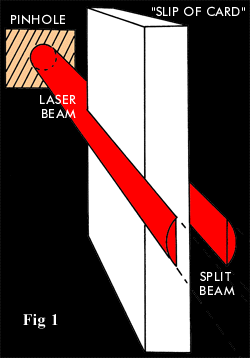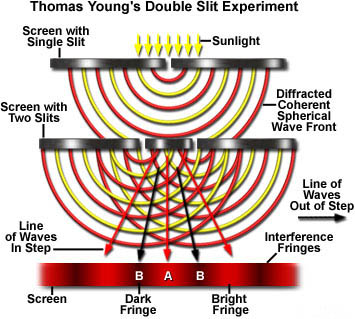|
|
In 1801, Thomas Young performed the double split experiment that proved light is a wave motion. Despite the name, the double split experiment was not down with a double split, but with a single split instead. When two light waves meet, some type of an interaction occurs. The rays from the sun being passed through a single slit in a screen produce light. The light is then projected onto another screen that has double slits. While passing through the slits, the rays again diffract the illumination. The results of interference between the diffracted light beams can be thought of light distributions on dark film. The distance between the slits can be altered, producing variations in the interference intensity patterns.
This experiment was based on the hypothesis that if light were wave-like in nature, then it should behave similar to waves that are produced in a pond. When two different waves meet, they should react in a way to either reinforce or destroy each other. Also, if the waves are in sync with each other, they should combine and create a larger wave. However, when two waves meet that and are not in sync with each other, the waves should cancel each other out creating a flat/calm area.
For Young to test his hypothesis, he created this experiment. Using sunlight through a small slit, he projected the light rays from the slit onto another screen containing two slits placed side by side. The light that is passing through the slits would then fall onto a screen where they could be observed.
He realized that when there were large slits, then two overlapping patches of light formed on the screen. In contrast, when there were small slits, the light produced distinct bands of color separated by dark regions in a specific order.
The basic setup of the double slit experiment is a red filtered light from sunlight is passed through a single slit. Light waves positioned close together are on a second barrier. A screen is placed in the region behind the slits to capture overlapped light rays that have passed through the two slits, and a pattern of bright red and dark interference bands becomes visible on the screen. The key to this type of experiment is the mutual coherence between the light waves diffracted from the two slits at the barrier. Although Young achieved this coherence through the diffraction of sunlight from the first slit, any light can be used to pass through the single slit.
|
|

